
by Ben Zackheim | Apr 22, 2014 | Book Promotion, Digital Identity, Sell your book, Writing |
Isn’t it fun to write about yourself? Wouldn’t you love to make a career out of coming up with new ways to talk about how interesting you are? Me neither.
Can author bios sell books? If you believe that a great cover, glowing reviews and a spot-on book description can sell books, then you’ll believe me when I say yes. The author bio is a featured data point all over the web. If a reader loves your bio, then imagine what they can get out of an entire book! Yeah, author bios sell books.
The fact is, author bios are the best way to make yourself compelling to a complete stranger who’s thinking about buying your book. Very few authors over the years have enjoyed crafting bios. But we still need them.
And we need to write more of them! For example, you need to tailor unique bios for your marketing efforts. Blogs, newsletters, deal sites, listings… many of them want a unique bio and book description when you submit. It’s frustrating but it makes sense. They don’t want their audience (or Google) to see them as redundant.
So here are some best practices that I’ve discovered on my journey. They’ve saved me time. They’ve made promotion just a tad bit easier just when I needed it most. And they’ve sold a few books!
Author bio tip 1. Your bio isn’t about you. It’s about your audience. Okay, technically that’s not true, but think about it. You’ve caught someone’s attention! That’s a big win! Don’t lose it by taking your eyes off of your goal here.
So make the bio appeal to your target audience. If that means showing off your snappy, friendly and entertaining self to sell your kids book, then cool. If you’re going for insightful, deep and intelligent for your paranormal romance then let it fly.
But please, whatever you do, don’t neglect your bio. It’s not below you. Some readers consider it a key part of their decision to buy, so treat your bio with the respect it deserves.
While all five of these tips will help you make a better bio, tips 2 and 3 are the best advice for how to write an author bio that sells books.
Author bio tip 2. Write the bio for the site where it will live, and mention your reading interests. As I’ve advised before, you should dig into the online store that you’re selling on. Even a smattering of research can yield insights that will help focus your bio.
What kind of books do you enjoy? Mystery? On Amazon you get the following drop-down results when you type that term in the search window:

On B&N:

My advice for this genre is to mention you like “mystery series” on your B&N bio. Mention you enjoy “mystery books” or “mystery and thriller” on your Amazon bio.
See what I’m doing there? I’m leveraging the site’s search engine to tell me what customers search for. All the terms that you see in the drop-down are arranged by popularity, so it’s great info that you can use to connect with readers.
I’ve written on this method of finding your target audience before, so I won’t belabor the point.
But one last thing, don’t get bogged down on this step. Really, what you should do is…
Author bio tip 3. Be passionate. When you write about your passions, your writing gets better. So mention your passions — hobbies, family, travel stories. It will help you connect with the reader.
Author bio tip 4. When you do finally get in the mood to hammer your way through your author bio, don’t just write one! Hey, you’re on a roll, so take advantage. Write five to ten quick and dirty bios that you can adjust later. Keep it in one file, somewhere safe. Then when you run into one of those sites that requires you to give them a unique author bio, you’ll have some fresh ones to choose from. Tighten it up and you’re done.
Author bio tip 5. First or third person? Great question. More independent authors are choosing first person. I think the reason for this is two-fold. One, it’s more comfy. Two, they want to convey their brand in a more casual way.
The counter argument is “first-person is amateurish and third person is professional.” The bios you read on books in the bookstore are rarely in first person, after all.
But I think most bios sound dull. And I’ll bet they’re dull because they’re written by authors who aren’t comfortable writing about themselves in the third person. Or they’re written by a hired hand who doesn’t know the author. Either way I lean toward first person myself because that’s what comes naturally.
How about you? Go ahead and paste your author bio in the comments section. We’d love to hear your thoughts on how to write an author bio that sells books!
By Ben Zackheim

by Ben Zackheim | Apr 13, 2014 | Book Promotion, Sell your book, Writing |
We need to eat. Forget it.
We need to go pee. We won’t.
We need to sleep. Yeah, right.
Writers go from one discomfort and life-draining behavior to another when we work on our stories. But then comes the dreaded moment when we must write a book description.
Suddenly the pain is too much to bear.
Most of us choke. But why? Maybe we feel that explaining the book will make it sound so bad (to us) that we’ll question why we even began writing it in the first place?
The problem with such a bad habit is this.
The fourth most important step to sell books online is the book description.
Fourth, huh? How do I figure that?
1) Write a great (professionally edited) book.
2) Have a great cover.
3) Put a few glowing reviews directly above the…
wait for it…
4) Yup. The book description.
The reader will know they’re on to something special when they spot a cool cover and enthusiastic responses from real readers. But the book description is where you’ll either close the sale or lose them. That means you need to treat it with the same respect you showed your story.
I want to talk about some critical steps we can all take to craft the best possible book description. And at the end of the post I want to share a new idea I had. I’m trying it out now and I think you should too.
Why is a great book description important?
Let’s first define what I mean by a “great book description.”
A great book description will help you sell books.
That’s why it’s so important. So for this post we’ll be honing in on the actual sale like a (super-friendly!) sniper.
Be warned. Part of what I’m talking about is number-crunching. Part is craft. There may even be some art to it. But the goal here is to give you all the info you need to produce an effective book description that sells books.
So. Rubber, meet Road.
How to write a book description that sells books
Tip 1:
Get reviews before you launch your book. What do reviews have to do with a good book description? We’ll get to that in a sec.
Reviews should live right above your product description. Don’t rely on the retailer’s reviews section to sell books. They build their product pages to sell a variety of products, not just books. Book pages need testimonials in a clear and obvious place — just like the back cover and flaps of real books.

Tip 2:
Using the reviews, craft your description. Show the potential buyer just how right the reviewers are! Act as a mirror to a couple of the key terms/phrases that your reviews use. If a review calls your book “an enlightening romp through one man’s middle life” then you can verify that in the book description by using words like “enlighten” and “middle life.” It’s a great way to subtly say, “That reviewer is so right!”
Tip 3:
The first sentence should be as good as your book’s first sentence. Remember how you pounded on the first sentence of your book until it was just right? Do that with your description too.
Tip 4:
Use terms that the online retailer’s search engine will love. Yes, we’re getting into uncomfortable territory here. Where’s the art in all of this, Ben? That’s up to you to find. But I’m obligated to tell you that Amazon scans your book description for terms that help its search engine find your product.
So be sure to include terms that reflect the genre you’ll be placing the book in. If your book is the story of a reporter investigating the death of her cousin at the hand of a serial killer at the start of World War II, then be sure you include terms like investigative journalism, World War II and serial killer in your description.
By the way, that’s my mom’s book, The Last Train to Paris. Go Mom!
There’s a cool way to check on what terms Amazon readers like to search for. Just use Amazon search! Enter a term that applies to your book. You’ll see a whole bunch of suggestions. Amazon is essentially telling you that these terms are what their readers are searching for. Use that to your advantage and find a word or term that’s a good fit. Choose a couple and put them in your book description.

So I should advise my mother to include the terms World War 2 historical fiction in her description. It’s appropriate to her book and it ranks high when people begin to type “Word War 2”. Of course, being my mother, she will ignore my advice.
Tip 5:
Target the shopper, not the reader.
Aren’t they the same? Probably, but not necessarily. I learned as a writer of books for young people that the book description must appeal to the adult who’s buying the book. Not the kid who’ll read it. A cousin of mine, Nerissa Nields, wrote a book that has “gift” written all over it, titled How to be an Adult. Yeah college graduates’ parents might want to jump on that one.
Tip 6:
Test! Post the description to your favorite online hangouts and ask for feedback. Send an email to trusted resources. Yes, that includes family and friends, as long as they have a good track record for giving constructive criticism.
I’ve found the community for BookGoodies on Facebook and the Createspace forums to be packed with people who love to give useful feedback.
If you’ve read this far then you might want me to cut to the chase and just get to this “new idea” I mentioned earlier.
Here it is…
Tip 7:
Don’t write an excellent book description. Write two excellent book descriptions.
Why?
The first will be for your launch audience. The second will be for the long-run.
What’s a launch audience? It’s the audience you know you have access to from the get-go. It can include your email list, your Facebook followers, etc. Did you read my post about Twitter analytics that help you identify your target audience? In a nutshell you can use Twitter to find out the specific interests of your followers. If you can identify specific interests of your followers then you can use words and terms that resonate with them.
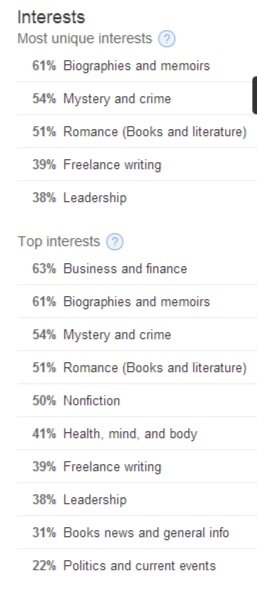
Yup. That’s a breakdown of my Twitter follower’s interests.
Go read the post. It lays out just how incredible this data is. It’s key to our never-ending quest to reach people who might be interested in our books. I wish Facebook offered the same robust insights, but they took the opportunity to charge us for targeted marketing.
Tip 8:
Tweak! Never stop adjusting the book description of your books. The beautiful thing about self publishing is that it allows you to make fast adjustments based on good data. If your book is suddenly newsworthy because of world events, then by all means head in and edit it! If a new term starts catching on that applies to your book, use it! You get the idea.
Conclusion:
A book description isn’t some alchemical element that could blow up in your face if you call forth the wrong incantation. It also won’t work if you just write, “Me book be gooder than your thinking it could of!” Find a process that works for you. Use your talent to write and use your curiosity about your audience to dig into what will make them more likely to click the Buy button.
By Ben Zackheim
Note: This post contains two affiliate links (in Tips 4 and 5), both of which are links to books on Amazon. One book is by my cousin, the other book is my mother’s. They’d better be fine with this, or Thanksgiving is going to be very uncomfortable this year.
[divider divider_type=”gradient”][/divider]
You might also like:
Amazon has a bridge to sell ya!
The $1.1 Million question: Is KDP Select worth it?

by Ben Zackheim | Apr 8, 2014 | Book Promotion, Digital Identity, Sell your book, Shirley Link & The Treasure Chest, Writing |
You hear the one about the two authors who walk into a bar? One has a mailing list. The other one has zip. Nada.
Mailing List: “I saw that tweet about your book sale the other day.”
Zip Nada: “Yeah. I got two whole sales after a week of prep, a $50 ad spend on Goodreads and 28 tweets.”
Mailing List: “Wow. That sucks.”
Zip Nada: “Thanks. That’s really helpful. I got your newsletter about your book last month. Looked nice.”
Mailing List: “50 copies sold. Not too bad. Why don’t you use your email list to promote sales?”
Zip Nada: “I don’t have one.”
Mailing List: “Oh man! It took me seven years to build mine! You’d better get started, like yesterday!”
What’s the punchline of the joke? Zip Nada punches Mailing List in the face.
If a writer doesn’t have an email list, does he make a sound when he falls in the forest?
Many writers experience dismal sales from Twitter/Facebook/[enter social network name here]. A common complaint is, “My followers are family, friends or fellow writers who don’t buy other writer’s books.”
We’re told that we should have an email list. That way we can reach the highest quality, most targeted audience possible.
Uh. I’m afraid all the above is true.
But…
Here’s some great (and little-discussed) news. If you use Twitter then you can reach your target audience. No matter what the “quality” is of your followers!
How?
Twitter Analytics, is a spectacular tool for finding people to buy your book.
You could say, “but that assumes my social network followers care about my books and they demonstrably do not.” This is a big misconception,and probably one of the most damaging to authors who blog, tweet and share online. We’re told by a lot of smart people out there that people who follow us, Like our posts or share our tweets aren’t necessarily fans, or even readers.
That’s a glass half empty (and incomplete) perspective.
Here’s mine:
The Twitter connections we’ve made online with non-fans and even non-readers are valuable enough to sell books.
How can that be? Because Twitter has learned so much about them!
Here’s what I mean. This is a breakdown of my Twitter following.

Is that a marketer’s ten thousand dollar breakdown of potential audience?
No, it’s Twitter’s free report on my followers.
Yup. They actually tell me what interests my followers have, even broken down by favorite genres! So for all my Twitter struggles and misses and successes over the years, in the final analysis it was my mere presence that gave Twitter the data it needed to say, “Hey, good job reaching out. Here’s who you have. Now go have fun selling your book to them!”
How does this help you? If you look at your own follower breakdown you’ll spot interests and terms that you can tweet about. For instance, using the data above, I just brainstormed a new tweet that I’m going to try:
Tweet: How do teenagers learn #leadership skills? Shirley gets crash course in #mystery Shirley Link & The Treasure Chest http://ctt.ec/n4z2o+
In that book, my heroine (Shirley Link) gets a lesson in leadership when she tries to get her two best (and bickering) friends to work together. All while dragging her dad around so he can help with the case.
So I’ve used two terms that I know (from solid Twitter data) will resonate with a huge part of my Twitter following: “mystery” and “leadership”.
But it doesn’t end there. You could apply this data to find terms for your book description, your book metadata and even blog posts about your book. Then when your audience clicks on the tweet they’ll see their favorite subject brought up again and again as they decide if they want to buy or not.
Conclusion: Get signed up for Twitter Analytics to find your target audience
So the lesson here is, you might not have a big enough mailing list yet. But as you build that up, don’t fret. Use Twitter and some common sense and you’ll find your readers.
Sign up for Twitter analytics here.
by Ben Zackheim
If you liked this post, give these a try!
WordPress for authors and writers (part four)
WordPress for authors and writers (part three)
WordPress for authors and writers (part two)
WordPress for authors and writers (part one)
Top 5 writing contests

by Ben Zackheim | Mar 26, 2014 | Book Promotion, Writing |
Goodreads giveaways are a wonderful way for authors to reach potential readers. Why? Because when you give away your book on Goodreads, you’re placing all of your hard work in the hands of someone who wants your book and wants to enjoy it. That last part of the sentence is important. Everyone knows that Goodreads is filled with readers. But one of the unspoken benefits of Goodreads is that people on the site are predominantly kind and supportive. Yes, there are exceptions. But people want to enjoy the books they read. This means you’ll find readers and they’ll be on your side from the get-go.
When you give away a book it’s different than giving away an app, for instance. Books speak to our hearts, minds, senses, emotions. By giving away our story we’re already ahead of the mad rush for people’s hearts that other businesses strive for.
The second biggest benefit of Goodreads giveaways is powerful. If you’re giving away a pre-release book, Goodreads will email many of the contest entrants with news of your book launch. More on that below.
Before you can tackle any of the steps here, you’ll need to sign up to be a Goodreads Author.
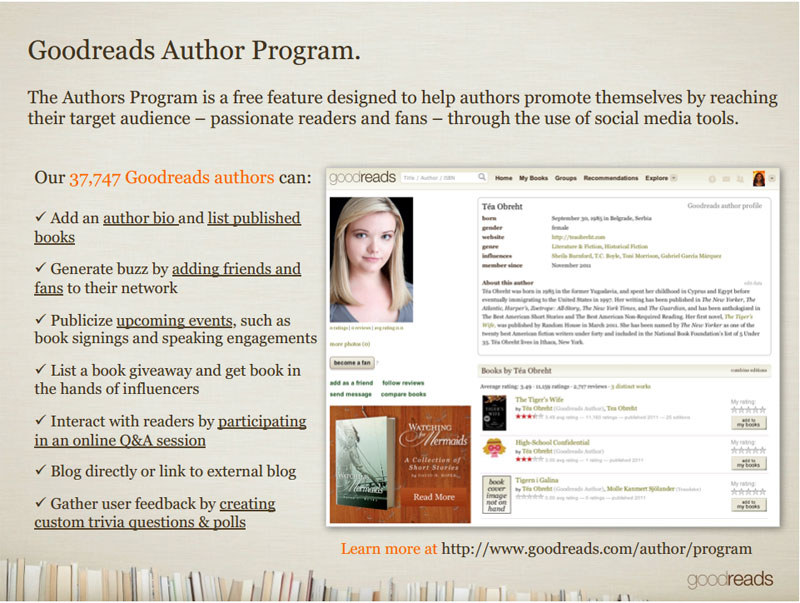
This requires you to have a book in their system. You can add your book easily. Just make a simple request to a Goodreads Librarian.
So once you’re an author with work on the site, here’s how you set up Goodreads giveaways:
1) Go to www.goodreads.com and sign up or sign in
2) Click on Explore in the upper right. Then select “giveaways”.
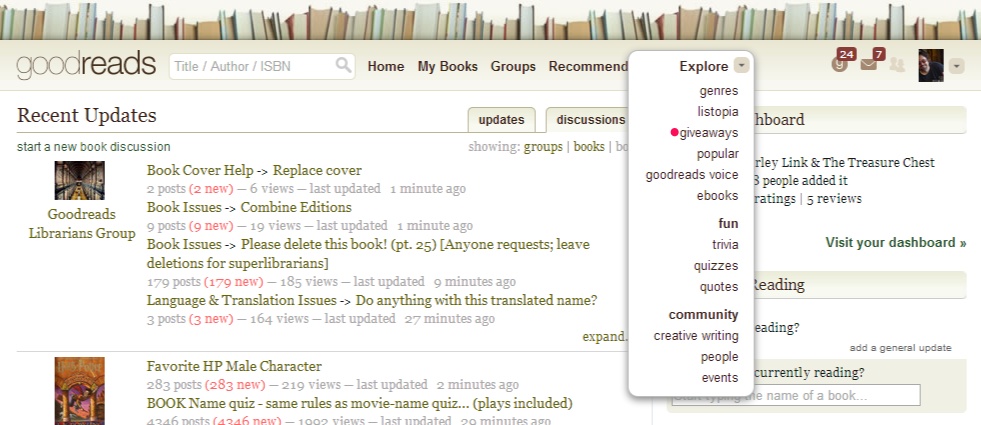
3) You’ll see a list of current giveaways. If you’ve signed up as a Goodreads Author you’ll see “List a Giveaway”. Select it.
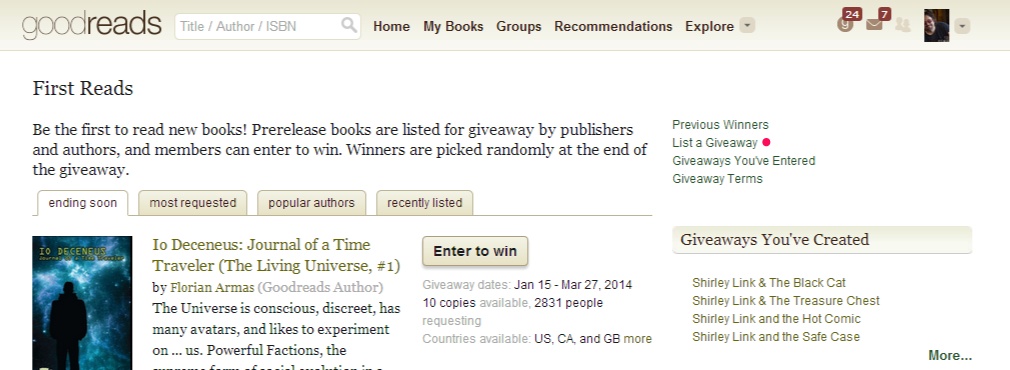
4) Here’s the listing page at last!
Look below the image to get the run-down.
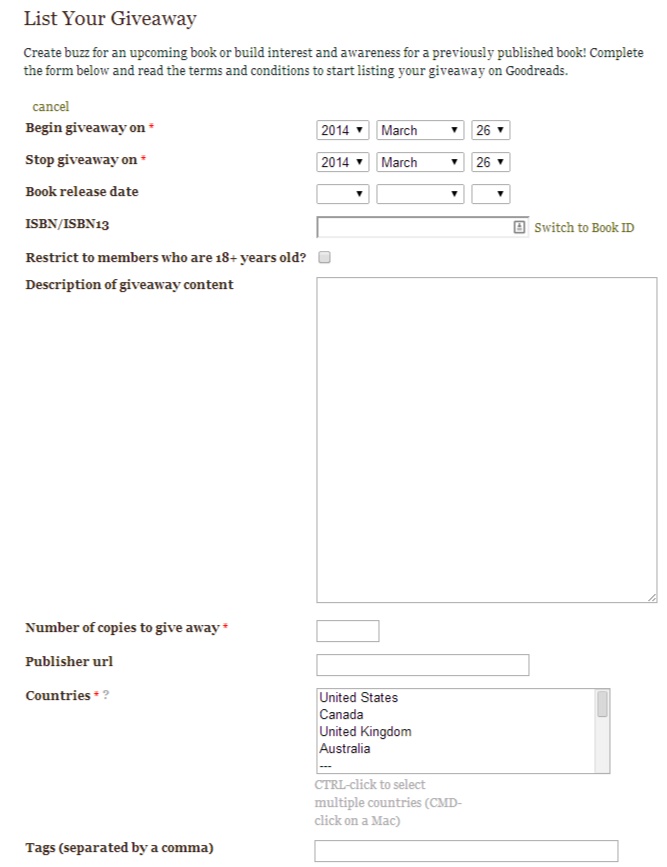

The “gotchas” and best practices are as follows:
-
Be sure to make the contest last a full month. Any less and you’re missing out on potential readers. In general, you’ll see the hugest spike in entrants as the contest deadline approaches, so fret not if things start slow!
-
Try to do the contest a full 2 months before the book launch. So when the contest ends you’ll still have a month to get feedback and reviews from your winners. And they’ll feel special that they got a book a month before it came out.
-
Enter your ISBN or ISBN13 in the field. If you only have an ASIN (Amazon’s ID format) then click on the “Switch to Book ID” link on the right side of the text entry field.
-
Make the description a kick-ass, direct pitch. The better the description, the more entrants you’ll get, guaranteed.
-
Goodreads likes to have authors give away 50 books. I agree that it’s a good number if you can afford it. I’ve done 10 and been happy with the results. However, I plan on following their advice with my next giveaway for The Camelot Kids. 50 copies, here I come!
-
If you don’t have a publisher then just enter your own site’s url. If you don’t have a site, please build one.
-
Choose the countries where you think your book will resonate. It’s a pain to send books internationally, but worth it if you can grow your global readership.
-
Tags are a whole post unto themselves. Enter terms that you believe apply to your book. You can use genre terms (horror, scifi), popular terms (Sherlock, Chicago Bears) or whatever comes to mind. The tags will help entrants choose the book that’s right for them.
-
The contact info is just asking you for basic info. Don’t worry about it. Just write something like “[Name], [email]. I’m the author of the book, [book name]
-
You can include an excerpt of your book for entrants to read. I’d advise doing this because the more people who enter who really WANT to win your book, the better your buzz will be.
Agree to the terms. They’re perfectly reasonable. Here they are for your convenience:
-
You agree to supply the indicated number of books on the date the giveaway ends.
-
Goodreads will list (for free) the giveaway book on the giveaways page.
-
Goodreads will collect interest in the book, and select winners at our discretion. Our algorithm uses member data to match interested members with each book.
-
After the giveaway stop date, click the name of your giveaway (listed under “your giveaways” on the main First Reads page) to see the list of winning addresses. You will also be emailed a list of winners. You are responsible for shipment of the books. Failure to do so will result in us not inviting you over for cake ever again.
-
You agree not to store the winners’ mailing addresses and not to use the winners’ addresses for anything other than sending them the indicated book.
-
Winning members are encouraged but not required to write a review of the book they receive.
-
Ebooks are not allowed. Every winner must receive a physical copy of the book.
Once you’ve started the contest you can retrace Steps 1-3. Notice the area on the right-hand side of the page that reads “Giveaways You’ve Created”? That will give you quick access. You can also find the contest listed on your Goodreads Dashboard
Now here’s the wonderful part. Everyone who enters your Goodreads giveaway will be opted-in to receive an email from Goodreads on the release date. That’s why they ask for the launch date of your book on the form above! In my experience about 75% of the entrants stay opted in.
That’s it! Now you need to promote the contest. That includes posting the Goodreads giveaway on linky (contest) sites and, yes, leveraging Goodreads advertising. I’ll post about that soon.
The final bit of usefulness comes from Goodreads itself. This slideshow is gold.
You might also find the following posts useful:
Does advertising on Goodreads work?
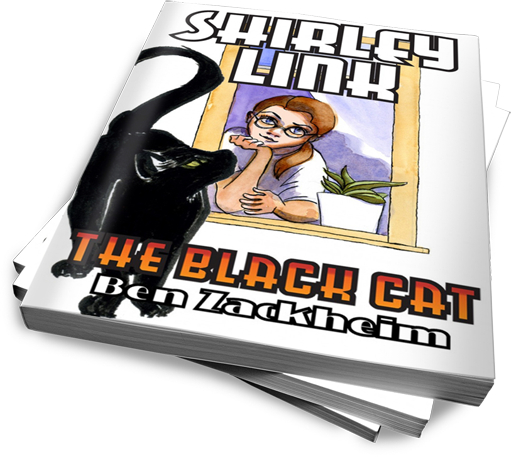
by Ben Zackheim | Mar 14, 2014 | Writing |

If you haven’t picked up the latest Shirley Link book, Shirley Link & The Black Cat, then now’s a good time. The Kindle ebook is a buck, today only.
I’m trying out the new Amazon Countdown Deal thingy. It lets me put a book on sale for a limited amount of time. I’ll be sure to post about my experience when all’s said and done.
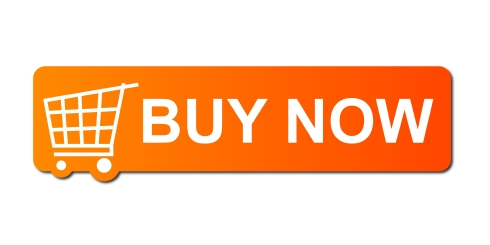
Want to know more about the fourth volume of the Shirley Link series (for middle school readers)?
Shirley Link, girl detective, is back in the critically-acclaimed Middle Grade mystery series! And this time, there’s a black cat involved…uh-oh…
In her fourth adventure, Shirley Link takes a walk on the dark side of her hometown. When a young man, known for making trouble, is targeted as suspect #1 in a string of robberies, Shirley works hard to find the truth.
But even if the young detective proves his innocence, can she save him from himself?
Join Shirley on her most daring case yet!
Emily Neuburger, Everyday Fun blog, Parents.com
“Shirley Link is a new girl detective series that my daughter is crazy about. This is an amazing series, my friends! Your kids will be hooked and you’ll feel really good about it.”
Edward Hemingway, Author/Illustrator, Bad Apple
“This Veronica Mars for the tween-set is funny, smart, and full of preternatural wisdom.”
PopBop (Top 1000 Amazon reviewer)
“There are early middle grade mysteries out there, but most of them have sketchy characters, and a lot of them plod along fairly predictable arcs. This series has an engaging heroine, a lot of attitude, and a much snappier overall feel.”
A great middle school read for girls and boys from 8-12 years of age (and their parents, of course)!

by Ben Zackheim | Mar 12, 2014 | Writing |
Research. I love it for the depth and flavor it adds to my work. I hate it for the time suck and endless re-searching it requires. See what I did there? RE-searching? Never mind.]
The folder in which I keep my research bookmarks shoots to the top of the Bookmarks drop-down window when I start a project. Then it ticks down to the bottom (below “Shopping”) as I get immersed in my concocted world.
Here’s a list of the best research sites for writers on the mondoweb, in my experience. I think one or two may come as a surprise. NOTE: I’m avoiding AI services for now. I’ve found them to be too authoratative in tone while being inaccurate and incorrect (in both details and context).
CIA
What do you mean, “Which CIA?” That CIA. If you want to get spectacular data in an elegant package then give the snoops a chance. It’s not really a surprise that they have useful info, is it? Though it may be a surprise to some just how available that info is.
Best History Sites
There’s nothing like an historically accurate story. What’s better than reading a great yarn that feels real? Best History Sites (.net) is a useful resource on a number of levels if you’re researching a time period. As the name implies, they gather the best history sites together in an easy-to-read package. I just got off an hour of browsing their links while researching this research post. Sigh.
BBC
These guys are doing history right. They’ve spent years posting quality articles, slideshows and media around world history. If you check out their A-Z section you will be lost in fascinating information.
WolframAlpha
The best resource for crunching numbers. But even more important? The best resource for excavating stories behind the numbers. Just type in your hometown’s name in the search field and you’ll see what I mean.
Reference.com
This was a tough one to recommend. It’s an ugly site with a lot of noise that has nothing to do with research, and a LOT to do with distracting you from your research. But if you can stay focused and follow the logic of their navigation, Research.com will give more than it takes.
Getty
Getty is great for art history and architecture from prehistory to today.
Refdesk
Refdesk calls itself the “Fact Checker of the Internet.” Used correctly, they’re probably right. The site is a treasure trove of info. You get everything from law dictionaries to gas price maps to contact info for local politicians. All on one page! Very Web1999, but I like it.
Google Scholar
Is it possible for me to get through a post without mentioning Google? No. Google Scholar has set out to give us a search engine for scholarly literature. You can find articles, books, court opinions, abstracts, and theses from a number of different sources. You can also arrange to check out books that contain the info you need, much like the resources listed below.
Online library resources are a fantastic place to research. But you need to know what you’re getting into. Be sure to check out the FAQs or the “How to Use” areas of the sites. It’s easy to get lost and feel like you’re getting the run-around. Some areas require membership and even university VPN connections.
Library of Congress
The largest library in the world. It was established to “support the Congress in fulfilling its constitutional duties and to further the progress of knowledge and creativity for the benefit of the American people.”
UCLA
I’ve linked directly to the UCLA research guides, which is a sufficient overview of their scope. From this page you’ll find a number of free access sources, and some membership sites.
Oxford
Oxford combines over 100 libraries in one. Wow.
New York Public Library
I’m partial to the NYPL images gallery for my writing research. If you live in NYC you can do a combo of online and stack research.
So off we go into research land. Try to find something no one’s found. Try to riff off of life and give us some great stories. But don’t forget to stay focused! ;-)

















